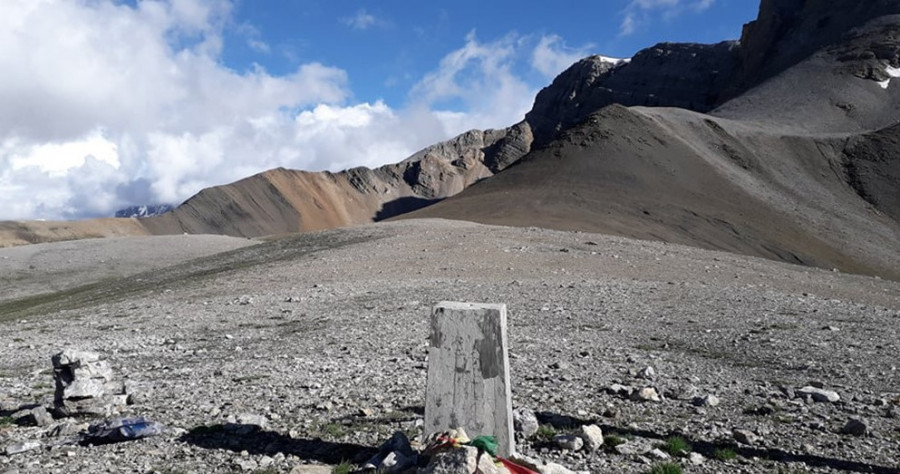National
Study panel says ‘there are issues’ along Nepal-China border in Humla
The committee has made a dozen recommendations and called for not politicising border disputes based on political ideologies.
Anil Giri
A host of issues has been identified along the Nepal-China border in Humla district, according to a report by a study panel formed by the Ministry of Home Affairs.
The panel led by Joint-secretary Jay Narayan Acharya submitted its report after conducting an on-field study to Home Minister Bal Krishna Khand in the last week of September.
Accordingly, the Ministry of Home Affairs had written to the Ministry of Foreign Affairs to take the issue up with Beijing.
The study panel has made a dozen recommendations, identifying the problems along the Nepal-China border in Humla, from border pillar numbers 4 to 13.
The report, parts of which the Post has obtained, stresses the need to include border issues in Nepal’s “state policy” so as to find a lasting solution.
“Such sensitive and bilateral matters related to the border need to be addressed through a permanent mechanism, but it is found that no such initiative has been taken,” states the report.
According to the report, since the 1963 Boundary Protocol has marked the area from pillar number 5 (2) to the middle of the Kit Khola as the boundary between the two countries, the territory belongs to Nepal.
“But it has been found that the Chinese side has put up wires and fencing in the Nepali territory,” says the report. “The Chinese side was also trying to build a permanent canal 145 metres inside the Nepali territory. Accordingly, it wanted to build a road. After Nepal’s Armed Police Force’s objections, the structures were destroyed and the covered rubble was visible.”
According to the report, the Chinese side has fenced and wired pillar 6 (1), which lies in the Nepali territory, and “attempted to” show its presence in the areas between pillar 6 (1) and pillar 5 (2).
“It was learnt that pillar 7(2), on the Chinese side, was not visible and it could not be found when local security officials from Nepal searched for it,” the report states.
The report says it found that the 1963 Boundary Protocol has been breached as the Chinese side has erected fences towards pillar 10, which is 32 metres from Nepal-China common pillar 9(2).
The report says the Chinese side has also been obstructing Nepali citizens from grazing their cattle in the areas between pillar 5 (2) and pillar 4.
The panel in its report has listed at least two “problems” that it identified during its study.
“As per the 1963 protocol, boundary demarcation is made on the basis of passes, watersheds and peaks in the Limi Lapcha area,” says the report. “The boundary demarcation in this area is south from the Pannum Peak, which is west of pillar 12, towards the watershed of the Lalung Pass and then towards north at the height of 5,165 metres. Going by this demarcation, recent constructions by the Chinese side fall within the Chinese territory.”
But, according to the report, the Lalung area falls within the Nepali territory. The presence of Chinese security forces in the Lalung area, through which pilgrims trek to Kailash Mansarovar in Tibet, has affected Nepalis’ religious activities, says the report.
“Locals say Nepal’s religious and tourism activities have been hampered and that their movement has been barred in their own area,” adds the report.
Yet another problem the study panel says it found is related to locals’ dependency on the northern side.
In Namkha Rural Municipality, especially in Limi Lapcha and Hilsa areas, Nepalis are highly dependent on the Tibetan markets across the border. “That’s why they are not only unwilling to protect the borders, but are also reluctant to speak on border issues. They appear to be concerned if such studies would affect bilateral relations.”
In a dozen of its recommendations, the study panel has called for addressing the border issues jointly.
“There has been a practice of addressing such issues through Joint Inspection Team, Joint Expert Group and Joint Inspection Committee,” says the report. “That’s why there is a need to activate these mechanisms.”
Stating that since the area southwest of pillar 5 (2) and the area north of Kit Khola up to the Karnali river are Nepali territories, the panel has suggested clearing the fencing [by the Chinese] in the area.
The panel has recommended keeping 10 metres of area from pillar 9(2) clear as per the Boundary Protocol and carrying out a joint inspection to “find” pillar 7 (2).
The panel has also suggested a joint boundary inspection as it has not been done since 2006.
“Since most of the problems were found to have been generated because of the locals on the Chinese side, there is a need to empower the local administration [in the Nepali side] and make it more responsible,” the report says.
“While carrying out a border inspection and reconstructing the border pillars, local people, local administration and local government must be kept in the loop so that people in the area know about their border and their rights.”
After it was revealed that there were problems in Humla district in the bordering area and people were facing difficulties, the Home Ministry on October 5 wrote to the Ministry of Foreign Affairs, asking it to take up the matter with China to resolve the issues amicably.
Multiple government sources told the Post that the Foreign Ministry has already taken up the matter with the government of China through the Chinese embassy in Kathmandu and that some rounds of discussion were held to resolve the dispute, if any, between the two sides through the established mechanisms.
On Tuesday, Foreign Minister Narayan Khadka and his Chinese counterpart Wang Yi, during a telephonic conversation, touched upon the boundary issue between the two countries.
“During the conversation, the two foreign ministers discussed the entire gamut of the bilateral relations between the two countries including Covid-19 vaccine cooperation, trade and commerce, development cooperation and border management,” the Foreign Ministry said in a statement.
Now the issue has come to the working level, according to a senior Foreign Ministry official.
“We are working to conduct a meeting for joint inspection of the border soon,” the official told the Post on condition of anonymity citing the sensitivity of the matter. “Officials from both sides will correspond and fix the date for a meeting and joint inspection.”
Home Ministry spokesperson Phadindra Mani Pokharel said that they have not heard back from the Foreign Ministry regarding their correspondence with Beijing.
“Whatever the findings, we forwarded them to the Foreign Ministry,” said Pokhrel. “They have not responded to us yet about what is happening with regard to our correspondence.”
As per the Nepal-China Boundary Protocol signed in 1963, the boundary line involves pillar 5 (2) and all the way to the middle of Kit Khola.
Nepal-China boundary pillars and their markings begin from Lipu Lekh on the east. Pillar 1 should be situated in Lipu Lekh but due to the boundary dispute between Nepal-India-China, pillar 1 has not been installed. The boundary pillars then follow east of Lipu Lekh up to Taplejung where pillar 99 is installed.
The border issue with the northern neighbour recently surfaced after Jeevan Bahadur Shahi, a Nepali Congress provincial lawmaker, reported that China had changed the alignment of boundary pillar No 12. He had presented his field study report at the Karnali Provincial Assembly in November last year. He had also called on the Karnali provincial government and the federal government in Kathmandu to carry out a detailed inspection by a joint team of Nepal and China.
After Shahi’s report made it to public domain, on December 4 last year, then foreign minister Pradeep Gyawali had said there was no encroachment by China in the Limi area of Humla.
“Similar issues had surfaced four years ago and the government had sent a team to carry out a study. But it was found that the buildings in the bordering area were actually within Chinese territory,” Gyawali had said.
But before the issue died down, the Chinese embassy in Kathmandu wrote to the Nepali Congress regarding Shahi’s report on border issues in Humla, much to the chagrin of the party, which was then in the opposition. The Congress party took exception to the embassy letter, saying it breached the diplomatic protocol.
After Nepali Congress’ Sher Bahadur Deuba came to power on July 13, some party members had raised the issue of border dispute with China. Deuba had then committed to forming a panel to study border disputes, if any, with the northern neighbour.
Accordingly, the panel was formed under Acharya and had six members.
Nepal and China concluded the first ever boundary talks in 1961 and signed the Boundary Protocol in 1963. Later in 1963, the two sides completed the demarcation and agreed to install 79 major pillars and 20 sub-pillars.
Later Nepal and China renewed the Boundary Protocol in 1979 and 1988. A senior official at the Department of Survey told the Post that it has made several communications through the Ministry of Foreign Affairs to hold a joint inspection after boundary meetings stalled in 2011.
“The last time we wrote for joint inspection of the boundary was before the joint announcement of the height of Mt Everest [in December last year],” said the official. “We have yet to get a response from the Chinese side.”
The Acharya-led panel also discusses how sensitive issues like boundaries between countries often are made political and opinions are formed in such ways as to affect bilateral ties.
“Nepal-China relations are based on development cooperation as well as political and economic activities. It is also necessary to strengthen the relations by seeking cooperation and partnership based on equality,” the panel said in its report. “But on the boundary issue in Humla, Nepali political fraternity is divided. It would be appropriate not to make the border an issue of debate on the basis of political ideologies.”
Boundary experts say that since the study team has identified some issues, there is a need to immediately take the matter up with China to find a lasting solution. It should not be dealt with by tactics and no one should resort to obfuscation, according to them.
Buddhi Narayan Shrestha, former director general of the Department of Survey, said that the time has come to reactivate the dormant joint inspection committee between Nepal and China to resolve the disputes.
Shrestha, who is considered an authority on boundary issues, said that some systematic issues were left in Humla along the Nepal-China border.
“This time, our probe team used the GPS facilities. Was a survey around pillar No 12 conducted or not?” said Shrestha. “China has put up a huge metal wire fence… what is the status of that fencing?”
“As per the protocol, no side can install or put up a fence or wire around the border pillar unilaterally, because it is a sovereignty issue. In pillar No 6(2) also, China has been fencing unilaterally. If any side wants to fence or wire anything in the bordening area, it should be done from the no-man’s land. Both fencing and wiring should be removed from pillars 9(2) and 6(2),” said Shrestha.




 6.73°C Kathmandu
6.73°C Kathmandu










%20(1).jpg&w=300&height=200)




